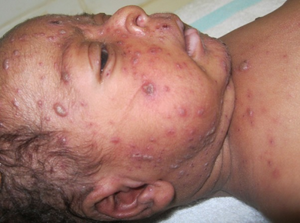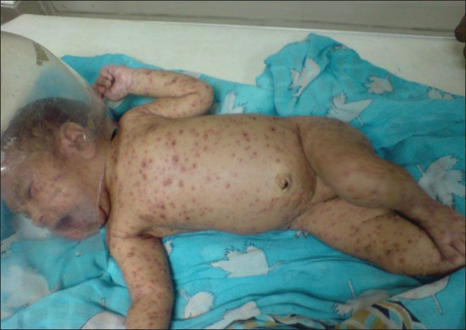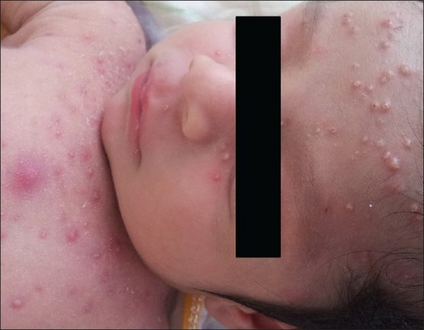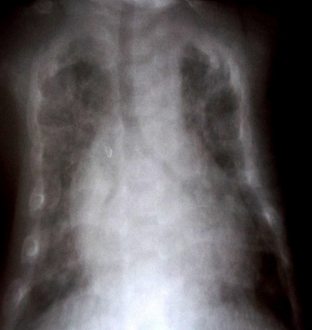Neonatal varicella
| Neonatal varicella | |
|---|---|
 | |
| Chickenpox exanthem (macules, papules, vesicles and crusts) | |
| Specialty | Pediatrics |
| Symptoms | Fever, spots, small bumps, small blisters, crusting |
| Complications | Pneumonia, hepatitis, meningoencephalitis, death[1] |
| Usual onset | Birth[2] |
| Causes | Varicella zoster virus in late pregnancy[2] |
| Risk factors | Chicken pox in late pregnancy[2] |
| Diagnostic method | Visualisation, PCR of blister swab[1] |
| Differential diagnosis | Neonatal herpes[1] |
Neonatal varicella is chickenpox infection in a newborn baby.[2] Symptoms may be present at birth or begin a few days later, typically with a fever followed by an eruption of spots that become small bumps which progress to small blisters before crusting.[1] These spots generally start on the head, and appear at various stages of development, before usually healing over a course of a week to ten days.[1] Complications include pneumonia, which may lead to death of the baby.[2] Other complications include hepatitis and meningoencephalitis.[1]
An affected baby typically contracts the Varicella zoster virus from their chickenpox affected mother during delivery, via direct contact with blood and chickenpox spots.[2] Less commonly, infection may occur via the placenta in the 20 days before birth, or just after birth by direct contact with respiratory droplets or skin.[2] When an unborn baby is infected in early pregnancy, it may result in congenital varicella syndrome.[1] Neonatal varicella may be more severe with a risk of death of 30% if the mother develops chickenpox between the five days before giving birth and the two days after.[1][3] Babies born After 5 days of the mother's onset of chickenpox are generally expected to have milder illness due to the mother's antibodies having crossed the placenta.[3] Diagnosis is by visualisation and a history of maternal varicella, though PCR of swabs of the blisters may help if uncertain.[1] Neonatal herpes may appear similar.[1]
Prevention is by vaccinating women who are not immune to chickenpox with the chickenpox vaccine.[2] Administering VZIG may prevent the disease in an exposed baby.[1] IVIG and aciclovir are alternative preventatives.[1] Treatment includes isolation and aciclovir.[1] Breastfeeding can continue.[1]
The infection presents in up to half of babies born to mothers infected with varicella in the last three weeks of pregnancy.[2]
Signs and symptoms
-
Neonatal varicella (macules, papules, vesicles and crusts)
-
Neonatal varicella (macules, papules, vesicles and crusts)
Complications
-
Chest X-ray: Diffuse interstitial syndrome in both lungs
See also
References
- ↑ 1.00 1.01 1.02 1.03 1.04 1.05 1.06 1.07 1.08 1.09 1.10 1.11 1.12 1.13 Singh, Srijan; Sharma, Akash; Rahman, Mohammad Mozibur; Kasniya, Gangajal; Maheshwari, Akhil; Boppana, Suresh B (2022). "Congenital and Perinatal Varicella Infections". Newborn (Clarksville, Md.). 1 (3): 278–286. doi:10.5005/jp-journals-11002-0040. ISSN 2769-514X. PMID 36540194. Archived from the original on 2023-09-10. Retrieved 2023-09-09.
- ↑ 2.0 2.1 2.2 2.3 2.4 2.5 2.6 2.7 2.8 Blumental, Sophie; Lepage, Philippe (30 May 2019). "Management of varicella in neonates and infants". BMJ Paediatrics Open. 3 (1): e000433. doi:10.1136/bmjpo-2019-000433. ISSN 2399-9772. PMID 31263790. Archived from the original on 10 September 2023. Retrieved 8 September 2023.
- ↑ 3.0 3.1 Yeh, Sylvia H. (2022). "13. Varicella zoster virus infections". In Jong, Elaine C.; Stevens, Dennis L. (eds.). Netter's Infectious Diseases (2nd ed.). Philadelphia: Elsevier. p. 57. ISBN 978-0-323-71159-3. Archived from the original on 2023-09-13. Retrieved 2023-09-11.


